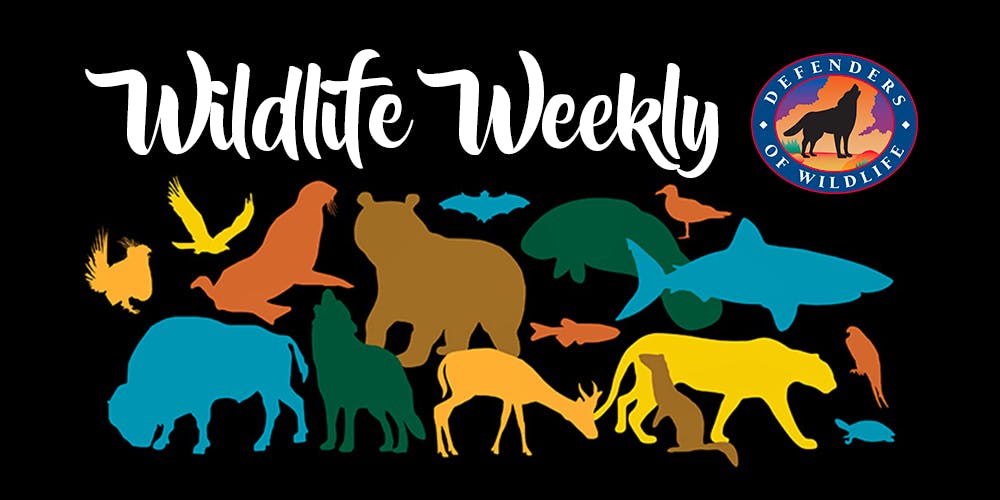Your weekly roundup of wildlife news from across the country.

We released a new analysis on the loss of habitat for the dunes sagebrush lizard in West Texas. Take a look!
Victory! Tongass National Forest in Alaska remains protected.
Thanks to the Endangered Species Act and protections like AB-711, championed by Defenders, California condors – once facing near extinction – are soaring again.
Exciting news! The first wild-born black footed ferrets were spotted outside of Meeteetse earlier this month.
It’s Sea Otter Awareness Week and we can’t get enough of these otterly adorable creatures! Otters are beloved for their charismatic nature and playfulness, but did you know they also play a key role in their ecosystem? Check out the amazing things sea otters do for their habitat and how you can be a friend to otters!
This year’s celebration of National Public Lands Day carries special weight as Secretary of the Interior Zinke and the Trump administration threaten the future of our national monuments and the wildlife that call them home.

In California:

California Desert Representative Tom Egan, braved the traffic of U.S. 395 south of Red Mountain, California on 21 September 2017, to rescue a large male, adult Agassiz’s desert tortoise (Gopherus agassizii). Fall is an active movement season for this cold-blooded reptile, which has been listed as threatened under the Endangered Species Act. Highways, in particular, act as significant mortality “sinks” for the relatively slow-moving tortoise. This particular tortoise was moved a tenth of a mile away from the very busy highway into native habitat.
Unfortunately, the native habitat and public lands this tortoise was moved to, have been identified by the U.S. Bureau of Land Management as the North of Kramer Solar Development Focus Area, where utility-scale solar farm siting is being encouraged. Defenders has been working to protect these public lands for both Agassiz’s desert tortoise and the elusive Mohave ground squirrel (Xerospermophilus mohavensis), which has been listed by the State of California as a threatened species. At the previous urging of Defenders and others, the California Department of Transportation installed considerable desert tortoise exclusion fencing along the southern reaches of U.S. Highway 395 and State Route 58, which have eliminated most tortoise mortality associated with vehicle travel on these highways. However, “smart-from-the-start” renewable energy facility siting and more highway fencing is needed for California’s official state reptile.
In North Carolina:

On September 14, the Asheville team held its final Workshop & Walkabout for 2017 – Return of the Raptors. The free public event celebrated the southern migration of raptors through western North Carolina with a live raptor presentation by our friends at Balsam Mountain Trust. The event was sponsored by the Asheville Museum of Science who opened its doors to 117 event-goers that evening. Thanks to Balsam Mountain Trust we got up close and personal with a red-tailed hawk, American bald eagle, eastern screech owl and barn owl. Participants also learned about behaviors, habitats, and threats facing raptors, including big weather events like hurricanes that can impede migration. For those who could not attend, we went live on Facebook with the presentation. To view it, click here, join our Carolina’s Facebook Group and go to Videos.
On Saturday morning, we hiked to the summit of Mt. Pisgah in Pisgah National Forest with high hopes (pun intended) of viewing hawk kettles rising on thermals and shooting through the valley. As luck would have it, we were a few days early and saw only one hawk in at the trailhead parking lot, but we exceeded our goals to explore, have fun and build community, and a good time was had by all!
In Ohio:

On September 20, Aimee Delach, Defenders’ Senior Policy Analyst Climate Adaptation, participated in a discussion following a screening of the documentary “Chasing Coral,” which documents an effort to capture time-lapse photography of the massive coral bleaching event that struck the Great Barrier Reef in 2016. Aimee spoke about climate change impacts to corals and other marine life and discussed ways we can make progress on climate change resilience and greenhouse gas reductions. The event was part of Ohio University’s Sustainability Film Series. Click here to read our coral reef fact sheet!





Follow Defenders of Wildlife
facebook bluesky twitter instagram youtube tiktok threads linkedin